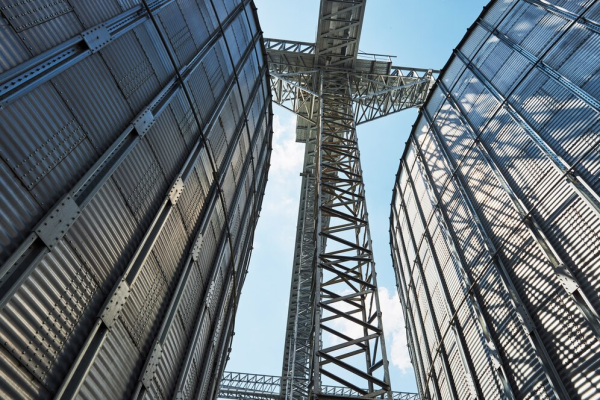Unmanaged water in and around industrial buildings poses a major threat to structural integrity.
From foundational erosion to interior moisture leaks, small water-related problems have a tendency to exponentiate into behemoths over time, disrupting operations and putting the safety of building occupants at risk.
With this in mind, keep reading as we explore some innovative materials for creating water-resistive systems in industrial construction.
A water resistant barrier is a crucial component of a water-resistive industrial building. Sometimes referred to as “building wrap,” it is typically fabricated of spun bonded polyolefin or engineered fabric and is positioned between the building’s exterior cladding and exterior sheathing.
It helps keep water that has leaked or seeped past the initial cladding from entering the building’s interior. Most water resistant barriers are integrated with flashing and system accessories in a shingle-lap fashion.
The success of the application depends on correct, continuous configuration of details at key interfaces, such as window-to-wall or roof-to-wall transitions.
Rainscreen Cladding
On the subject of water resistant barriers, many are included as part of a comprehensive rainscreen cladding system. Many industrial buildings that experience a high level of precipitation are using rainscreen cladding for premium waterproofing.
The system uses a load bearing wall, insulation layer, and cladding material that is fixed to the building using a support structure. This creates an air cavity between the load-bearing wall and cladding material for continuous ventilation.
In addition to the elite waterproofing, the appeal of modern rainscreen cladding systems is that the initial cladding material can use engineered materials that closely resemble wood or brick to give the building an inviting, rustic appearance that sets it apart from the gray concrete walls traditionally associated with industrial structures.
Hurricane-Grade Storm Windows
Modern industrial buildings are understanding the importance of natural light. It can create a more inviting ambiance and boost the esteem of employees. However, poorly integrated windows are a natural point of water ingress.
The best sealant for water leaks can help fortify degraded window frames and prevent air and moisture transfer. More extensive renovations involve the installation of hurricane-grade storm windows.
Fabricated of structural steel frames and reinforced glass panels, these top-quality windows offer the highest wind and impact resistance on the market, ensuring that industrial windows remain moisture-tight in all conditions.
Foundation Waterproofing
Water damage to an industrial building’s foundation is potentially catastrophic. Most foundations compromised by water are expensive or even impossible to fix. As such, foundation waterproofing is a crucial component of industrial building design.
Liquid flashing is a primary method of water resistance that can keep concrete foundations from absorbing moisture from the surrounding soil.
However, more comprehensive waterproofing will likely be necessary for areas that experience a high level of hydrostatic pressure in the groundwater. The most robust foundational waterproofing will involve a series of fully-adhered permeable membranes.
Once water passes through the membrane, it is directed to a drainage mat that sends the water to a subterranean pipe system and away from the building, making it the ideal waterproofing solution in areas that experience heavy water flow.
Sustainable Insulation
One often overlooked aspect of industrial construction is insulation. Not only does proper insulation contribute to energy efficiency and interior comfort, but it also plays a significant role in sustainability efforts.
Sustainable insulation materials, such as recycled denim, cellulose, or natural wool, not only provide excellent thermal performance but also reduce the environmental impact of the building.
By incorporating sustainable insulation into industrial construction projects, builders can minimize their carbon footprint while maximizing energy savings.
Comprehensive Roofing Infrastructure
Most industrial buildings feature flat roofs. They will be required to accommodate much greater traffic than typical residential roofs. To handle the additional compressive force, beams and girders must be in top condition.
In addition, structural b-decking can add shear support to the roof, limiting the risk of acute damage by transferring vertical loads to the building’s frame.
As commercial flat roofs will often feature a series of vents, solar panels, skylights, and access hatches, it is essential that the correct roof curb detail is in place.
This helps ensure that the roof can handle these additional components without experiencing damage that could lead to water infiltration. Finally, all industrial flat roofs should have continuous and properly-lapped coping over the roof and wall ends to keep bulk water out of the building enclosure.
Permeable Parking Lots
Water runoff around an industrial building’s exterior increases the risk of erosion that could threaten the structure. As such, many commercial facilities are bypassing sprawling concrete parking lots in favor of permeable options.
Using a series of substrate grids that hold gravel, stone, or sod in place, permeable paver grids promote stormwater absorption that helps keep the exterior of the building safe from heavy runoff.
In addition, substrate erosion and freezing/thawing can take a major toll on the viability of traditional asphalt and concrete parking lots, making permeable options a better choice for ongoing performance.
A Complete Water Resistive System for Industrial Buildings
A complete water-resistive system involves the careful integration of various materials and components.
With the correct material selection and proper application, modern industrial buildings can become ostensibly waterproof. For more of the latest trends in industrial construction, explore CCE Online News for the leading insights in the industry.
Also Read
Construction starts for West Africa’s largest solar plant in Mali
The role of demolition in circular construction

